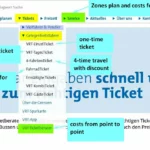Last Updated on 22/04/2023
This topic is all about trains in Germany: how to buy a ticket online or from a vending machine, what signs can be on the platform and on the train, what tickets are available for local trains, and what discount tickets you can buy for day trips. The topic is divided into two parts. In the first federal railways, the site bahn.de, buying tickets for long routes. In the second part, everything related to Regional transport in Germany
Local public transport in Germany
Public transport around Lake Constance
Tourist and guest cards of Lake Constance
Germany by car
Timetables and train tickets online
Main German transport site – www.bahn.de, and it is not so difficult to deal with it in general, there are different languages. For those who have not coped, here is a guide using the example of the German version (as the most complete).
Similar forms, only in a simpler interface, are offered in the smartphone application. There you can buy a Handy ticket. To do this, install the application in advance, connect the payment and remember the password. The application works crookedly and a lot of time is spent on it. In most cases, you cannot buy a ticket in two clicks in one minute.
Important: it has become impossible to buy a ticket on the train, both in regional and high-speed trains. Therefore, just in case, have the application downloaded to your phone at hand. It is inconvenient to use it, but sometimes it does not work out in a different way.
Important: Handy ticket cannot be transferred to another person! A scan or printscreen is not a ticket, you will be fined. You can buy a ticket for another person, but the ticket is only valid with the phone through which it was purchased (rare nonsense, especially for families with teens). We already got caught when I was traveling with a friend of my son, whose mother sent me his 9-euro ticket.
Timetable at bahn.de
On the main page we see a window with a quick search for trains and tickets. Since the next step you will be highly likely redirected to an extended search, we start with it. If you weren’t redirected to the advanced search, but were immediately given results, you can get there by clicking “Edit data” (Angaben ändern) and “Edit other data” (Weitere Angaben ändern).
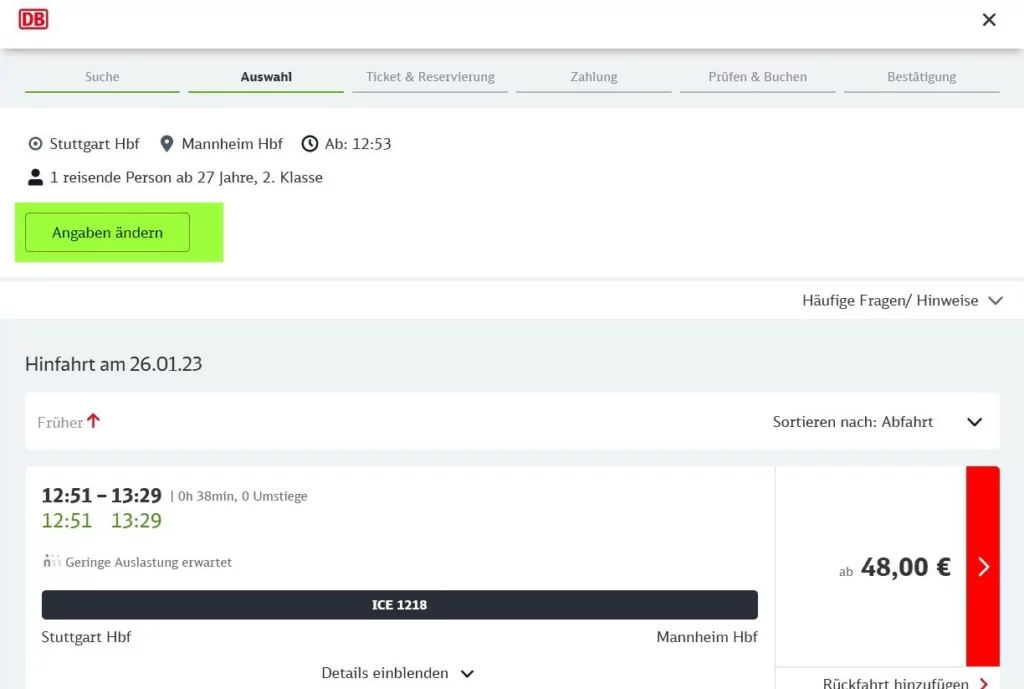

We get such a picture.

Choose a place of departure, a place of destination. You can specify either the departure time or the arrival time. The second is convenient if you have something scheduled at your destination and you need to arrive on time.
The checkbox for local transport is needed if you want to cut off high-speed trains, as you are going to buy a land ticket or other tickets that are valid only for local transport.
If you are going to get off at a intermediate station or drive along some beautiful road, do not be too lazy to enter a Zwischenhalt. The route to the end point is not the only one. If you need the fastest option, then do not enter anything.

For example. To get from Stuttgart to Mannheim, we can choose from several options. The first one, the fastest (40 min) and the most expensive one, we will get if we use the quick search or if we do not enter anything in the advanced search conditions. For the rest, much more picturesque, the Baden-Württemberg ticket and other local tickets are valid, which are cheaper. In order to get these options, you need to search Nur Nahverkehr and uncheck Schnellste Verbindungen anzeigen. And then you find out that:
- you can travel through the Kraichgau region with one change in Karlsruhe
- or via Kraichgau region with one change in Heidelberg
- and also via Sinsheim and Heidelberg
- and finally you can go through Mosbach along the Neckar valley with one transfer in Mosbach or without transfers
Travel time from 1 hour 40 minutes to 2 hours 30 minutes. Of these options, the last three are much more beautiful than the high-speed one. Moreover, the route along the Neckar valley is the most recommended as very picturesque, although it may turn out to be the longest.
Read more about Neckar valley:
Castle Road (Burgenstrasse). 1. Neckar cycle route Mannheim – Eberbach
Castle Road. 2. Neckar valley cycle route. From Zwingenberg to Bad Wimpfen
If you only want to reserve a seat, but not buy a ticket, check it at the bottom of the page (Nur Sitzplatz).
How to deal with the “puntuality” of German trains
In recent years, the chances that the train will not be late are not very high. Add here the principle of a short transfer in the German timetable – most transfers are designed for 5 – 7 minutes wherever you go. As a result, you get that you miss the transfer due to being late. Everything would be fine if in 20 minutes you could take the next train. But you will get the next train in an hour, because another principle of the German timetable is the “once an hour” takt. In rare cases, it happens twice an hour.
How to deal with it?
If the S-bahn is the first on your route, go one train earlier.
If the regional train goes first and then a very important transfer that cannot be missed, go one train earlier.
If you have a chain of trains:
- uncheck “Schnellste Verbindungen anzeigen” and see what options there are at all
- try to put the longest piece at the beginning of the route
- choose long transfers – if you choose short transfers, you will most likely not make it in time and will wait for an hour
- if you choose short transfers (there are no others, this also happens), try to do them at large stations where there are other trains on this route and where you can at least eat
- avoid “bad known” stations. For example, it is better not to choose trains that go through Stuttgart.
- do not put the last train of the day at the end of the route if it is impossible / expensive to get there by taxi! Count on a one train delay (at least).
Searching results
After filling in the page with the search terms, go to the results (Button Suchen).

To get detailed information, click on the option you like (Details einblenden). If none of them fit, you can look for trains later (später) or earlier (früher).
Notice some useful features. You can sort trains (Sortieren nach) by departure time (Abfahrt), arrival time (Ankunft), travel time (Dauer), number of changes (Umstiege) and price (Preis).
When you open one of the options, you can also view the timetable for that line online (that is, see where the train is) by clicking on the train number. At the bottom there will also be:
additional information about the train,
notifications,
information about the station (mostly large ones),
the sequence of cars in the train.
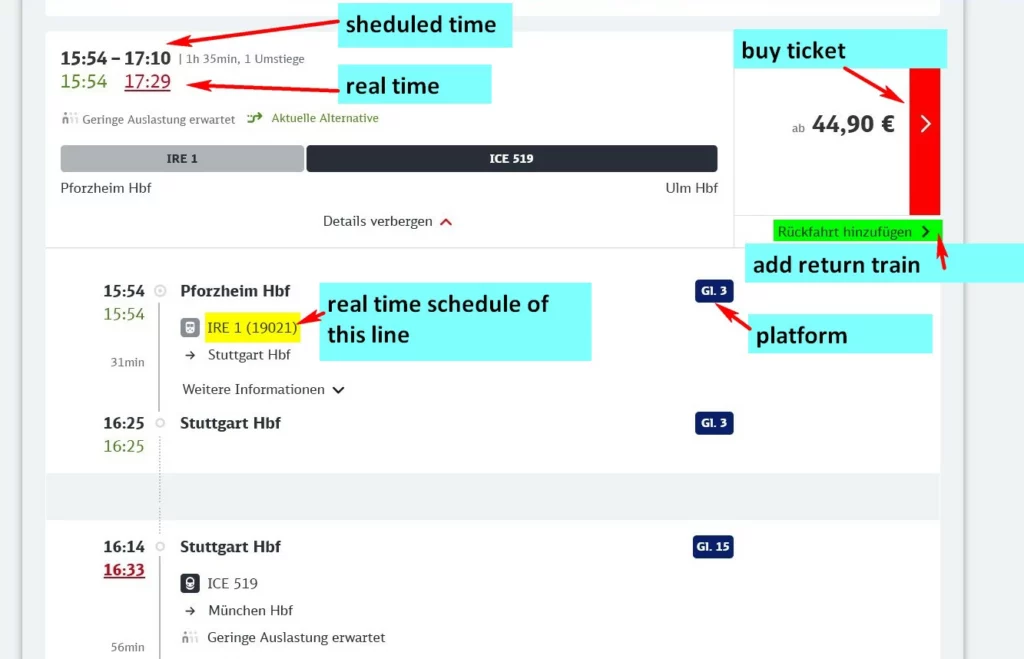

Sometimes rail service is interrupted at some point for repairs. Instead of the train, there is a special bus. It leaves 5-10 minutes after the arrival of the train. This will be indicated in the schedule under an exclamation mark. Under the same exclamation mark, there may be other messages: that the train does not take wheelchairs or that there are some other problems on the route.
In this case, the train is canceled, another one goes instead.

Booking a ticket on bahn.de
Buying a ticket online or at a vending machine is cheaper than at the box office at the station, where you will be charged extra money for service.
Having chosen a suitable option, we proceed to booking a ticket (Zur Buchung). You will be prompted to select a rate.
For example I took a complex route that includes local transport.

Normal fare (flexible) means you can use any train on that day on that route.
Economy fare (Spar) means that you need to travel on the specified trains at the specified time. Economy fares can be of different levels of economy – with or without a city ticket, with the possibility of exchange or not.
I am offered the following rates:
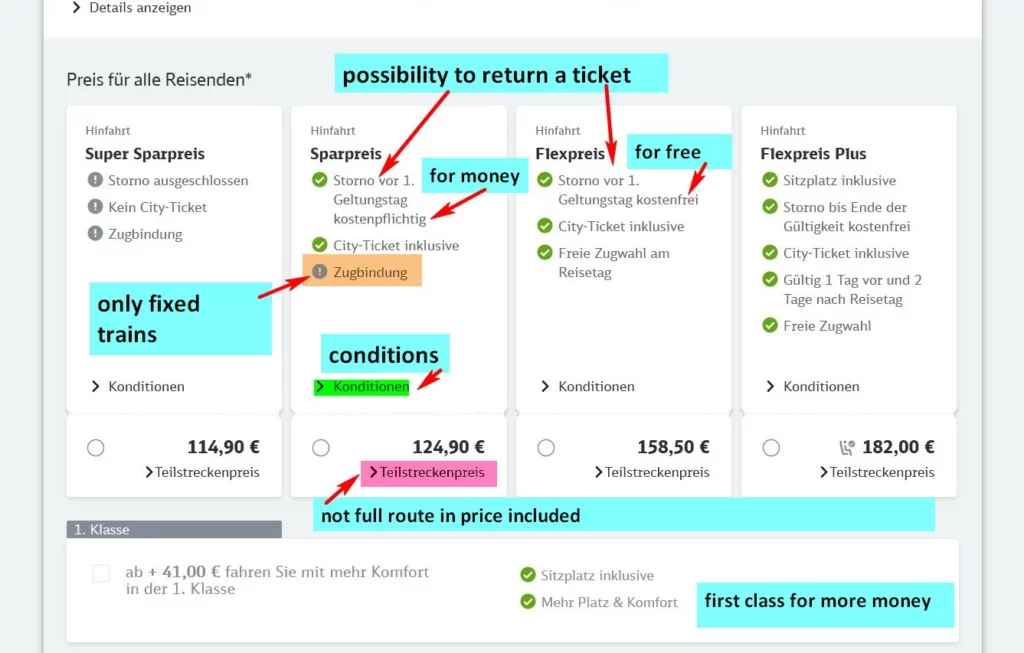
Please note that the price does not include local transport. If there is a City-ticket in the city and you have chosen a fare with this ticket, then local transport on the day of the trip will be free, but if this ticket is not available in the city or you have chosen the most economical fare, then you need to pay extra for local transport.
To see which sections are not included, click on Teilstreckenpreis.
In my example, the starting point lies outside the city ticket.
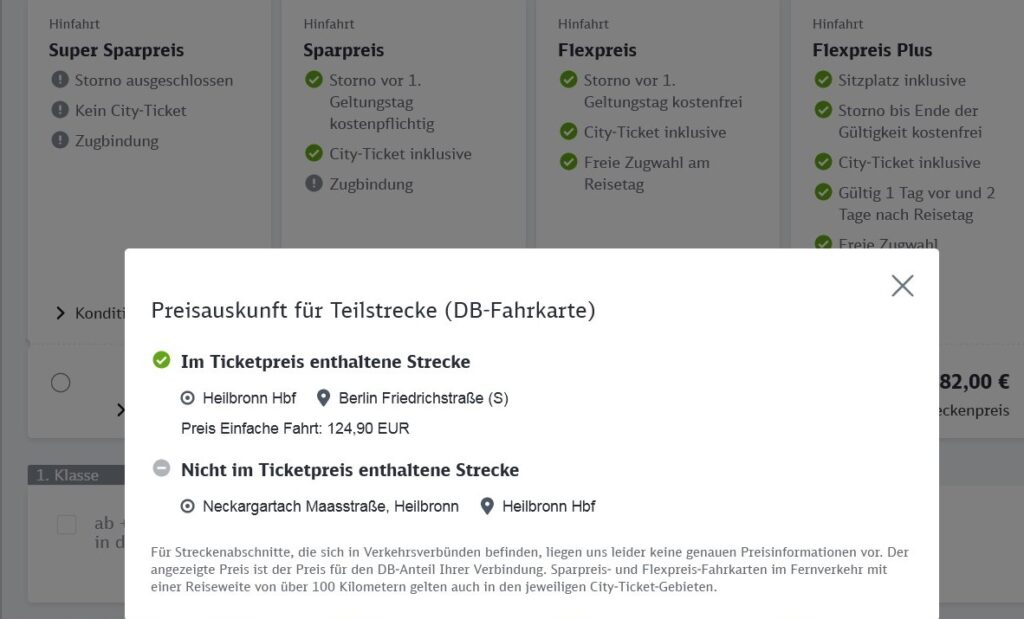
Read about regional and other tickets with special conditions in the second part.
At the next step, you can reserve a seat, choose a delivery method and buy trip cancellation insurance. The easiest way is to choose an online ticket that can be printed.
Ticket reservation is optional, except for some high-speed trains. However, during rush hour, it is useful, since you may not find a free seat and you will have to stand in the aisle.
Important: on the train, you must have the same credit card with which you paid for the ticket.
Additional features of the website www.bahn.de
In the tab “Tickets and offers” (Tickets und Angebote):
Sparpreis – advantageous tickets if you book well in advance and are not bound by certain dates
Regionale Angebote – regional offers
The Probe BahnCard makes sense if a quarter of the amount of all trips planned during its validity exceeds its cost. Don’t forget to count the bonus it offers (tickets for kids or local transport).
Night trains are experiencing a renaissance, so it makes sense to check out these offers. So just in the schedule you will not meet them. The issue must be studied in advance, especially since there are night trains from other countries.
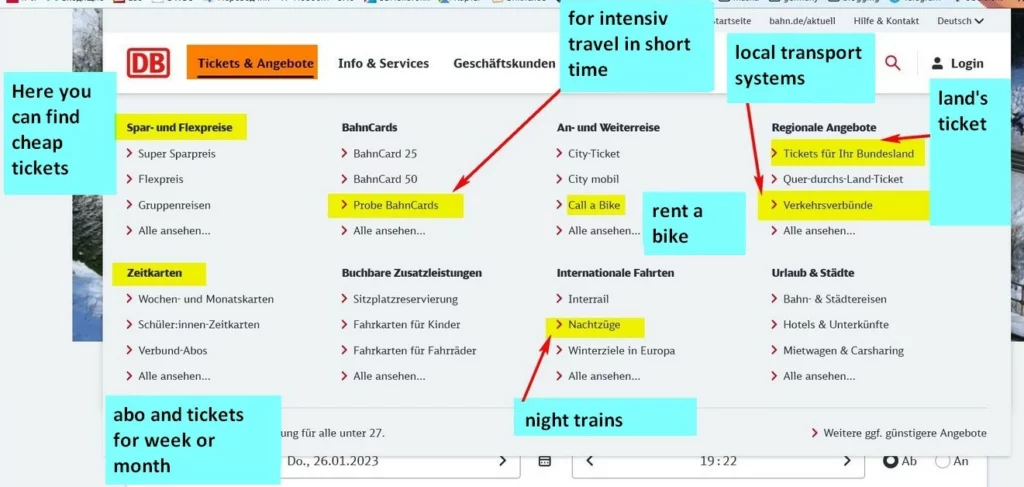
In the tab Info & Services:
Fahrpläne und aktuelle Meldungen. Here you need to click on this general heading in order to get all the offers, in particular, the schedule for stations and individual for a specific route, maps and plans, current delays, etc.
You will need the Informationen zur Buchung section if you want to return your ticket or claim a refund.

Buy train ticket in Germany for long distances in the vending mashine
These are standard Deutsche Bahn vending machines. The difference will be in the Verkehrsverbund section – each region has its own transport system – and in the Gesamtes Angebot section – there are special offers in different lands.
Algorithm:
1) Select the language at the bottom of the screen.
2) Select the desired section. Usually are offered:
Start Ziel (buying a ticket),
Fahrplanauskunft (timetable),
Gesamtes Angebot (offers, land’s ticket, etc)
and Verkehrsverbund (local public transport system, sometimes two, if a town stands on the border).
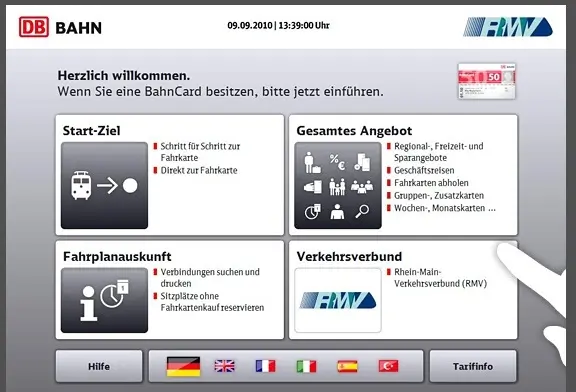
In the first two options (buying a ticket or a schedule), we get to the “Place of departure” page. The default is the station you are at. Button Start ändern – change the place of departure. Choose from the proposed options or enter your place of departure (if you need to change it).
Next, we do the same with the destination.
Zurück – step back, Weiter – the next step.
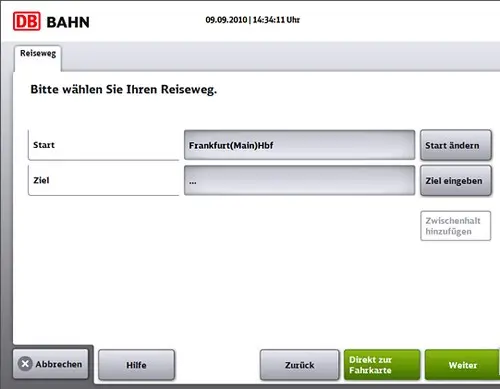
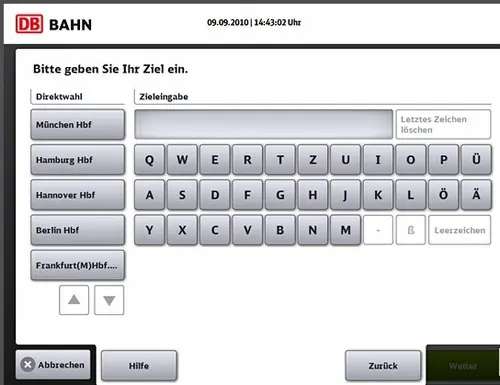
Next:
one way or day return,
how many persons,
whether you have Bahncard (mostly – Keine BC),
what trains you need. If you are looking for a timetable for a local ticket (ticket of a region, federal state, weekend, etc.) – choose nur Nahverkehr.

The next step is the date, time. After that, they give out a schedule (with prices if you chose the ticket purchase section).
There is the date, departure time, travel time, number of transfers, type of trains. If you click on the arrow next to the selected train, a detailed schedule will appear along with the platforms. It can be printed (Drucken), the general shedule can also be printed. Use the up / down arrows on the right to scroll to the desired train.
Sparangebote – tickets, usually valid only for this train / trains, you can return them with a loss of some amount (depending on the conditions).

Click on the selected ticket. The next step is to reserve a seat if you wish. The last step is a general review of the purchase. You can pay with banknotes, coins, credit cards.
Train tickets in Germany at federal state level
It is important when buying tickets:
which type of train you are traveling – high-speed (ICE, IC, EC) or regional (IRE, RE, RB, S)
and which class – first or second.
Controllers go all the time. In extreme cases, you can buy a ticket from them, but you will have to explain why you did not buy a ticket in advance. And the reason must be very serious, like the breakdown of a single ticket machine. It would be nice to stock up on a witness or sit close to people who, like you, could not buy a ticket. In addition, you cannot buy discount tickets from the controller, such as a day ticket or a federal state ticket, you can only buy a ticket “point to point”.
A regular one-way train ticket is quite expensive, if you buy it on the day of the trip. But there are many discount options. This part will focus on tickets for relatively long distances. For trips around and to neighboring cities, you need to carefully study the website of the local transport system.
Local public transport in Germany
Children 6-14 years old
Children under 6 travel with their parents free of charge.
Children from 6 to 14 years old with their parents or grandparents also very often travel for free by Deutsche Bahn. For example, children can travel free of charge with their parents if they are purchased:
- land’s ticket (for adults, i.e. for one parent or two parents or grandparents), for example Bavarian ticket
- ticket Quer-durchs-Land-Ticket (for adults)
- ticket with BahnCard25 – in most cases only tickets from DB, not from the regional transport association
- ticket with Sparpreis tarif
- ticket with Normalpreis tarif
All this applies to your own children or grandchildren. Other children are considered separate travelers.
When you buy a ticket (exept land’s ticket), be sure to indicate the entire group at once so that the data about the children get into the ticket.
For children 6-14 years old, you need to pay at the children’s rate on trams, buses, metro, local trains, if separate tickets are bought. But more often on local transport it is more profitable to buy a family / group ticket.
BahnCard 25, 50
A train card is needed for those who regularly travel by train. But if you are going to do a big tour of Germany or a couple of long routes across the country, then there is an opportunity to pay off BahnCard 25 or Probe BahnCard 25 promotional option. The promotional option appears and disappears on the bahn.de website. It makes sense to choose it – the period of validity is shorter (and the tourist does not need more) and the price is also less. Just remember to cancel the auto-renewal of this trial card. Automatic renewal can be canceled through the Service Center using the contact form. The link can be found in the Frequently Asked Questions section on the website (question about Kündigung).
A regular BahnCard 25 costs about 62 euros and gives you a 25% discount on all train tickets. In addition, there are various bonuses. For example, a City Ticket will allow you to travel around the city for free on the day of travel. To see if the card pays off, you add up all our Deutsche Bahn railroad expenses. If you have more than 250 euros (62 euros (cost of the card) x 4), you can buy a card.
For Probe BahnCard it is easier:
– Probe BahnCard 25 costs around 18 euros – your expenses for travels should be more than 75 euros. You can pay it off with the first long travel.
– Probe BahnCard 50 costs around 73 euros – your expenses should be more than 150 euros.
Offers for speed trains
Not only on local trains you can buy a ticket cheaper. There are also special offers for high-speed trains. For example, Europa-Spezial – cheap travel tickets from Germany to neighboring countries.
The earlier you buy a ticket, the more likely you are to buy a special offer ticket.
There used to be a separate search for cheap tickets. Now in the usual search, you can activate the “show the best prices” function (Unsere Bestpreise anzeigen). Of course, this is less convenient, since you then have to check all the days you can travel for the best price.
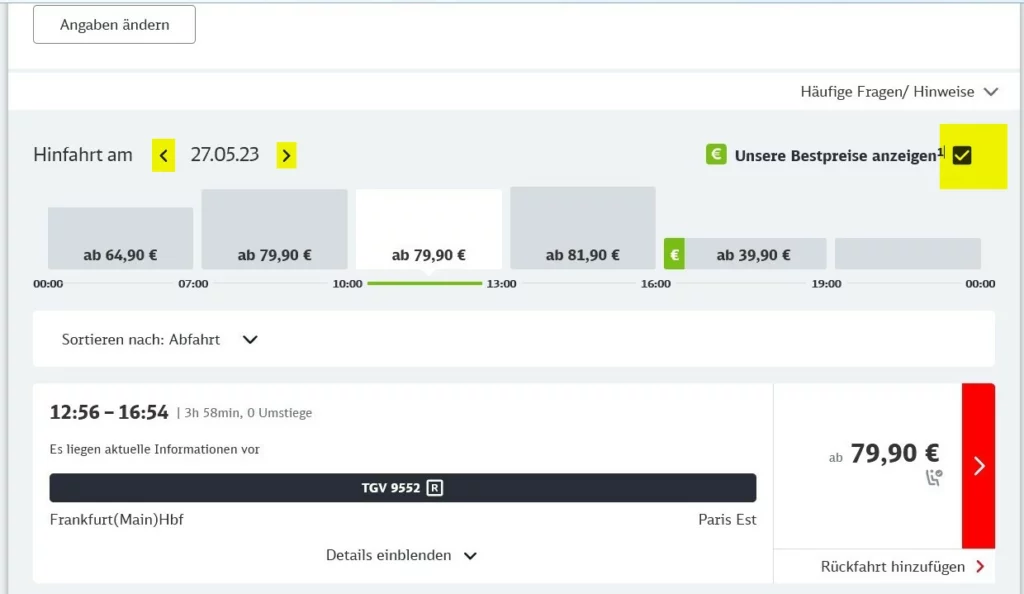
Tickets for regional trains
From May 2023 you can buy a German ticket for 49 euros. It is monthly subscription, therefore you should read the conditions and do not forget to cancel it.
More about German ticket: German ticket for regional public transport Deutschland-Ticket
For the majority of those who regularly use regional transport, the German ticket will be more advantageous than the old abos. If you use regional transport occasionally you should calculate.
Länder-ticket and Quer-durchs-Land-Ticket are no longer so attractive. But you should definitely still calculate if you are traveling in a group or with children.
Land’s ticket (Länder-ticket) and other offers for long distance with regional trains
This tickets you need, if you travel for long distance, but with regional trains. It is cheaper, moreover it can be more beautiful routes.
Land’s tickets can be, for example:
Bavarian ticket, Bavarian-Bohemian ticket, Prag Spezial
Baden-Württemberg ticket, metropolitan ticket
Hesse ticket
Rhineland-Palatinate ticket, Luxemburg Spezial and Saar-Lor-Lux-Ticket
Saxon ticket, Saxon-Bohemian ticket
Brandenburg-Berlin ticket
Conditions for Länder-ticket: up to 5 people (but not necessarily exactly five), after 9 a.m. (usually) on weekdays or all day on weekends, only local trains and only second class.
If adults are traveling with their children, the usual rule is no more than 2 adults and as many of their children under 14 as you like. That is, a family of 2 adults and 4 children under 14 will only pay for 2 adults.
Ostsee-ticket – a similar ticket, only not from the federal state, but from some cities (for example, Berlin) to the cities of the Baltic Sea.
The Länder ticket can also provide small discounts from 50 cents to 3 euros on entrance tickets to various museums and attractions.
Quer-durchs-Land-Ticket
The Quer-durchs-Land-Ticket costs 44 euros for one person. Each next (there can be up to 5 people in total) pays another 7 euros. Own 3 children from 6 to 14 years old, accompanied by adults, travel free of charge with this ticket.
The ticket is valid on regional trains (RB, IRE, RE, S-Bahn) in the second class throughout Germany. The time limit is from Mon to Fri from 9 a.m. to 3 a.m. the next day. On the Saturday and Sunday from 0.00 a.m.
This ticket is suitable for those who are going to cross the borders of two or more federal states during the day (while traveling on slow regional trains).
Please note: if you are traveling within one federal state – choose a federal state ticket.
If you are traveling within two lands, it may be more advantageous to buy separate tickets for these two lands. Moreover, the land’s ticket is valid, as a rule, also on buses and public transport, and for this ticket only railways are indicated.
On the station
German train stations in large and medium-sized cities are usually quite pleasant. There is where to eat, there is often a press in foreign languages, there are usually decent, albeit paid, toilets. In the underpasses or at the train station itself, there is very likely to be a drogerie (a type of store selling cosmetics, hygiene products, some drinks, foods like biscuits, sometimes also simple medicines/vitamins, toys and stationery), a small grocery store, bakery.
Unfortunately, small stations are mostly closed or given over to other purposes, and you should not count on any kind of service there. Ticket offices are also available only at fairly large stations, at others – only vending machines.
Plans of the largest stations, information about all stations (for example, parking, availability of left-luggage offices, etc.) can be found on the www.bahnhof.de.
The main board, which shows the departure of trains, looks like this. Since Deutsche Bahn does not allow to publish photos of its property on non-private sites, I make drawings.
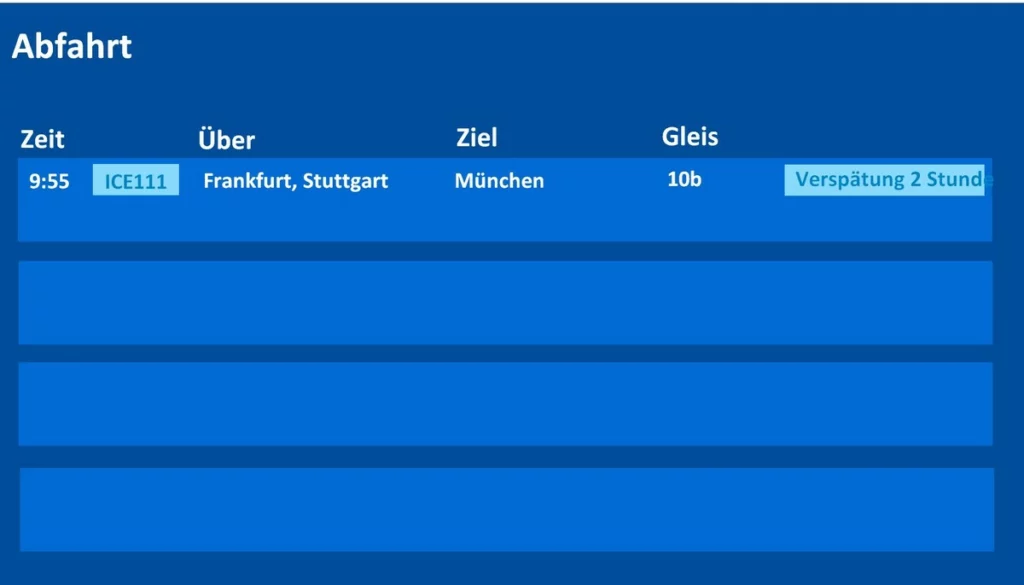
The first column is the time
the second is the train number,
third – intermediate stops,
the fourth is the destination,
fifth – platform,
sixth running line – additions and notes.
You find the number of your train and focus on columns five and six. There is a platform in your schedule taken from the Internet or in your paper schedule. But it can change, so you always look again.
In the last column, you can often find out a lot of interesting things. From the innocent remark that the train follows with the reverse numbering of cars, to announcements of strikes and delays.
Words Verspätung, später combined with time, it means that your train is late.
Streik – strikes,
fällt aus – canceled,
geteillt or Zugteilung – the train will be divided.
If something is written in front of your train, but you don’t understand what, it is advisable, just in case, to check with the employee in the form.
At a small station, there will be no board. And there will be paper timetables on the stands. One piece of paper – departure (Abfahrt), the other – arrival (Ankunft), do not confuse.
Studying this schedule, you need to be very attentive to all kinds of circles, dots, crosses, asterisks under the train time.
Let’s move on to our platform. It will also have a small board. In most cases, everything is simple. There will still be a train number, time, destination, intermediate stations and notes in the form of a highlighted ticker at the top.
I draw your attention to two options. First, “it is end station, please don’t get on” (Zug endet hier. Bitte nicht einsteigen).

The second refers to dividing trains and two trains on the same platform with different departure times. In Germany, both options are possible. In this case, the platform sector will be indicated in the schedule (for example, 10a). For example, in the picture, the first half of the train goes to Cologne, the second – to Aachen. The letters are the sectors of the platform, they are marked with large signs.
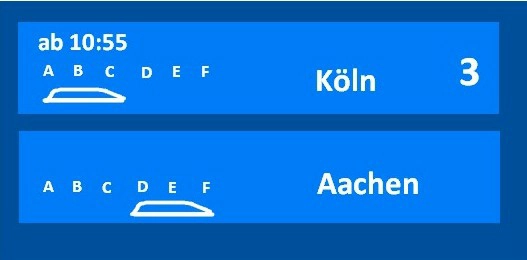
In the train
Getting on the train, pay attention to the class. It is written on the outside on the walls of the cars, on the doors of the car compartments.
In one car there can be departments of the first and second class. The first class is not much different from the second. Most often there is a compartment, fewer seats, maybe a table, and most importantly, there are simply fewer people. There are more differences in high-speed trains – the seats are much wider, there is more legroom, there is a built-in TV. If you find yourself in a first-class compartment, having a second-class ticket, you will be fined.
Seat’s reservation
When buying tickets for high-speed trains (ICE, IC, EC), they offer to reserve a seat for an additional 4.5 euros. If the train leaves in the morning or in the evening, almost all seats may be reserved or occupied and finding a free one can be a problem.
Above the seats they write from which station to which the seat is reserved. If you leave earlier, the place reserved for the next section of the route is quite possible to take. In addition, the bags and legs of passengers lying on the seat do not mean at all that the seat is occupied. Feel free to ask.
If you have reserved a seat on a high-speed train, this does not mean that you have to travel on that particular train. You can go earlier or later, if your fare allows it, or if the trains are late and for this reason you take another train. But you will lose your reservation.
Above the seats in high-speed trains may be the following inscriptions.
- Stations between which seat is reserved.
- “ggf. reserviert” – seats may be reserved, the system has not had time to update the data. You can take a seat, but be prepared that you must go at any time.
- “ggf. freigeben” – places left for reservations at the last moment. You can also take them, but be prepared to meet the owner.
- “bahn.comfort” – Seats are reserved for frequent travelers with a card
- “Schwerbehinderte” – places for the disabled, it is better not to sit.
Travel with a bicycle
Bicycle cars are marked with a bicycle sign. As a rule, this is the first and/or last car. The conductor has the right not to let you in with the bike if there is no room.
If you take a bike, you need to buy a special Fahrradkarte ticket for each bike for 6 euros (9 euros on high-speed trains). However, on local trains it is often free (at certain times or days). This information should be checked on the websites of local transport companies.
Local public transport in Germany
Do you enjoy the site without cookies? This means that I work for you at my own expense.
Perhaps you would like to support my work here.
Or change your cookie settings here. I don’t use personalized ads



